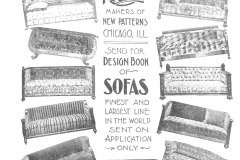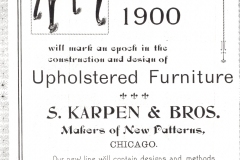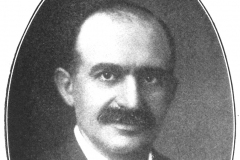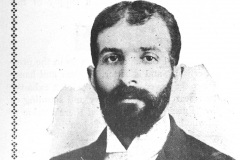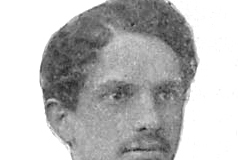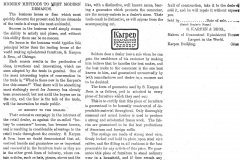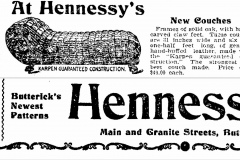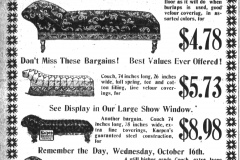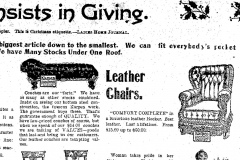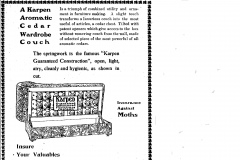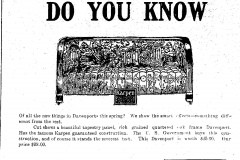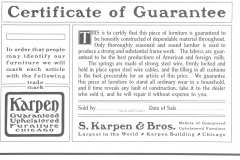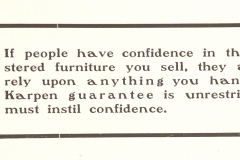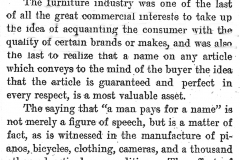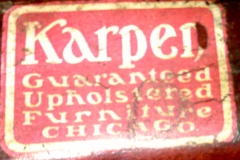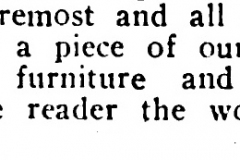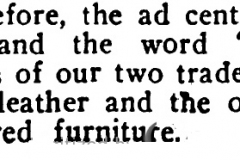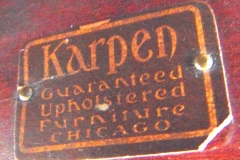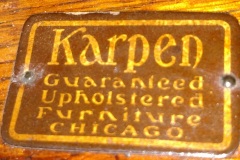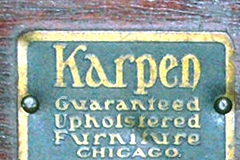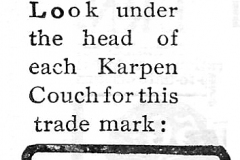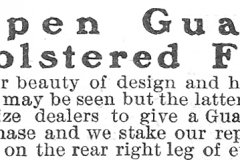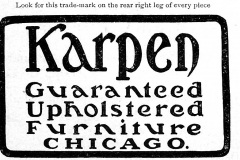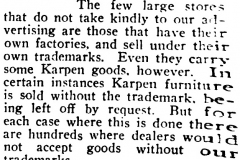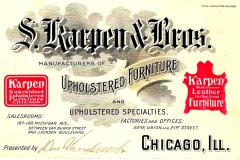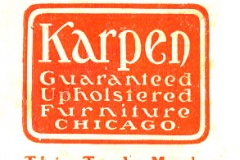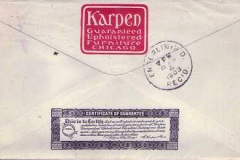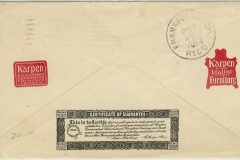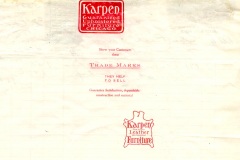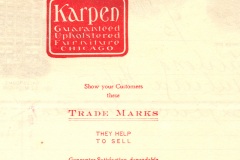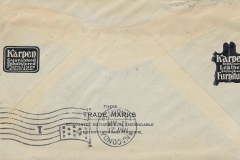Revolutionizing Furniture Marketing—Selling the Karpen Name: 1901
Confidence is, after all, the keynote in successful selling. Especially is this true of upholstered furniture, where the interior construction and material are unknown except to the manufacturer, and where every purchase must be made depending upon the faith which the buyer has in the maker of the article. —The Furniture World, July 28, 1904, 46.
It was working in a speculative field when the Karpen firm boldly broke away from the narrow views prevailing at the time and began affixing their trade-marked name to each piece of furniture which left their establishment. It was the day of small things, but the wisdom of their plan is now widely admitted to be beyond controversy. —S. Karpen & Bros., 29th Annual Catalogue (Chicago: S. Karpen & Bros., 1909) 2. Private collection, Emily C. Rose.
S. Karpen & Bros.’ marketing strategy in the last years of the nineteenth century and the first months of 1900 continued its emphasis on attracting dealers to its showrooms in Chicago, and offering useful catalogs to those who did not make that trip. While Karpen Bros.’ advertisements were more attractive and well-written, they were not that different than those of other furniture manufacturers. The tagline (a reiterated phrase connected with the Karpen name), “Makers of New Patterns,” appeared in almost every advertisement in the furniture trade papers. After the purchase of its new plant, the company did add several new taglines: “The Largest and Lowest Priced Line in the World” and “Finest and Largest Line in the World.” Prior to, and during the semi-annual markets in January and June-July, its full-page and half-page advertisements were in many furniture trade papers.The Karpen Guarantee
With the new century, however, a new era of consumerism began, and Karpen Bros. was the first furniture manufacturer to react to the new situation. Under Solomon’s guidance, certainly Adolph, as marketing manager, spearheaded the new campaign, and Julius contributed important creative ideas. The new plan unfolded within a few months at the end of 1900 and during 1901. They sent a press release to the furniture trade journals. Under the headline, “Modern Methods to Meet Modern Demands,” furniture trade papers heralded Karpen Bros.’ initiative to be the company to “discern the present and future demands of the trade:”[1] Karpen Bros.’ initiative was an outgrowth of its earlier marketing strategy of guaranteeing its product. [2] From 1883 onwards, its advertisements occasionally included quite restricted guarantees of the springs or other parts of construction. In June 1900, the furniture trade press wrote that “only at their salesroom can be seen the ‘Karpen Guaranteed Construction Couches,’ which are made w/o the use of slats, twine or webbing & which are guaranteed by S. Karpen & Bros. to be absolutely indestructible.” [3] They ran “a novel contest” that offered a $100 davenport (sofa) to the dealer who sent them the best written article on the steel spring support and steel-tied spring couch which was known as the “Karpen Guaranteed Construction.”[4] Then in fall 1900, the company expanded the guarantee significantly, which was first announced in the Chicago Day Parade when Karpen factory workers carried a huge sign reading, “We make guaranteed upholstered furniture.”[5]The furniture trade press viewed the guarantee as an “important and successful” marketing tool as it had been in the other great lines of industry, where certain articles, such as bats, pianos, stoves and the like, bearing a guarantee, which protected the consumer, were the money-makers in a dealer’s store.[6] Another furniture trade paper wrote in support of Karpen Bros.’ guarantee that “if we were to analyze the underlying cause of a dealer’s success, no matter what his line of trade we would find that his strength mainly rested in the infinite pains he has taken to inspire confidence.”[7]
The Karpen guarantee certificate was sent out with every piece of furniture and dealers were authorized to present it with every purchase.[8] The guarantee made a bold statement:
A few months later, the guarantee appeared in its advertisements with different wording: rather than the guarantee carrying no time limitation, the new guarantee was valid for only three years. That and subsequent advertising copy added more confidence-building wording:The quality of our furniture is fully covered by our guarantee. Ours is the strongest guarantee under which any furniture in the world is sold. [9]
Karpen upholstered furniture is famed for beauty of design and honesty of construction. The former may be seen, but the latter must be proven. Hence we authorize dealers to give a Guarantee Certificate with every purchase….[10]
The Karpen Bros.’ guarantee counteracted the fly-by night workshops and factories, which did not raise consumer confidence. Advertisements in the furniture trade journals featured the word “guarantee:” “All Karpen Furniture is fully guaranteed, and there can be no dissatisfaction in buying it;” [11] “A Guarantee Certificate goes with each purchase, making it the only safe upholstered furniture to buy.” [12]The furniture trade press wrote just a year and half after the guarantee’s introduction that the firm was building up a reputation for its goods that “in a few years would be more valuable in dollars and cents than the entire plant” in which the furniture was made. “A fire might destroy the buildings, but no one can take away the good will won and held by straight-forward dealing with the people who sell and the people who buy their goods.”[13] The firm showed “a progressive spirit in being the pioneers in standing back of the dealer with a guarantee that protects him and his trade.”[14]
The Karpen Trademark
Another Karpen Bros.’ marketing innovation was introduced simultaneously with its certificate of guarantee. At the end of 1900, it unveiled its original trademark: “Karpen Guaranteed Upholstered Furniture Chicago” in a stylized print style was set in a framed rectangle. Julius created the trademark around 1897. It was never registered. [15] The Karpens were well aware of the importance of patents and trademarks and the threat of infringements. We can only assume that with the inclusion of the Karpen name, they felt no need to register it.
Julius explained their reasoning behind the trademark at a meeting of the Chicago Furniture Manufacturers Association at the end of 1900:
In 1904 Julius shared his intent with the readers of the advertising journal, Printers’ Ink: The trademark design was simple, eye-catching, and informative. From the end of 1900 to 1902, the way the trademark was used changed slightly. At the end of 1900, a red label measuring 1.5″ high x 2″ wide was glued to an inside leg. The trademark was in white letters. A few months later, a thick beige cardboard tag measuring 1.25″ high x 1.75″ wide was introduced. The trademark tag was affixed with two tacks. Around 1902, a metal tag affixed with two tacks was introduced. The tag was a bronze rectangle with black framing and print, measuring 1″ high by 1.5″ wide. Karpen Bros. used this tag for decades with only minor changes in style and verbiage.Karpen Bros. trademark was affixed to each piece of furniture that left the factory.[16] Usually the label and then tag was placed on the rear right leg; in later years it was placed on the lower portion of the back frame.
Julius Karpen, in an interview in the advertising journal, Printer’s Ink, explained why a few large stores carried Karpen furniture without the trademark:Trademark on Communications
Karpen Bros. placed its trademark on its invoice forms and stationery, varying its placement over the years:
- Furniture World, Dec. 20, 1900, 12. Furniture Worker, Dec. 10, 1900, 64. ↑
- American Furniture Gazette, Fall 1884, xxv ↑
- Furniture World, June 11, 1900, 18. ↑
- Furniture Worker, June 25, 1900, 53. Furniture World, June 14, 1900, 18. [similar article] ↑
- Furniture World, Nov. 1, 1900, 18-19. ↑
- Furniture Worker, Dec. 10, 1900, 64. Furniture World, Jan. 3, 1901, 43. ↑
- Upholsterer, Jan. 15, 1901, 60. ↑
- Munsey’s Magazine, Dec. 1901, Advertising Section. ↑
- Munsey’s Magazine, Apr. 1901, Advertising Section. ↑
- Munsey’s Magazine, Nov. 1901, Advertising Section. ↑
- Upholsterer, Dec. 15, 1901. Furniture World, Dec. 26. 1901, 20. Furniture World, Jan. 2, 1902, 16. Furniture World, Jan. 9, 1902, 46. Grand Rapids Furniture Record, Dec. 1901, n.p. ↑
- Furniture Trade Review and Interior Decorator, July 10, 1901, 24. Furniture World, June 20, 1901, 36. Furniture World, July 4, 1901, 34. Furniture World, July 11, 1901, 14. ↑
- Furniture World, July 3, 1902, 44. ↑
- Furniture World, June 26, 1902, 30-1. ↑
- C. P. McDonald, Trade-Marks You Ought to Know. Some of Trade-Marks being used by well-known furniture manufactures, Together with Statements of Origin and Value to Users. Furniture Manufacturer & Artisan, Mar. 1914, 113. ↑
- Furniture Worker, Nov. 10, 1900, 34. ↑
